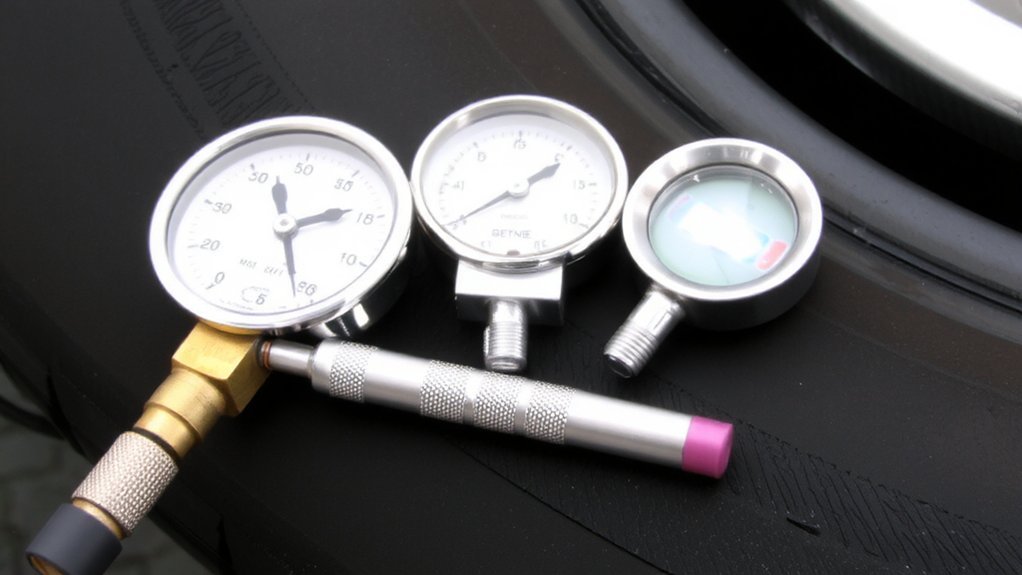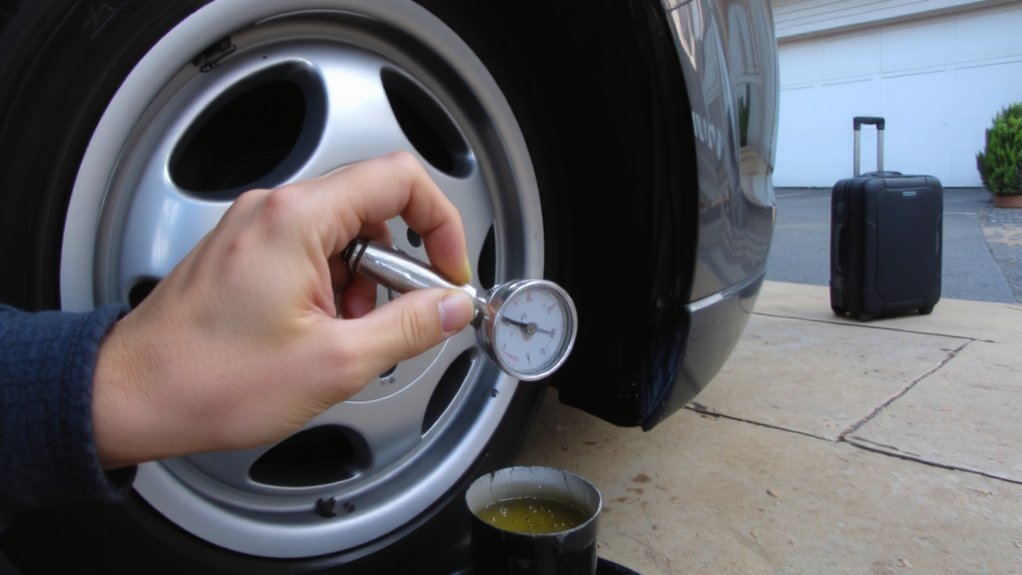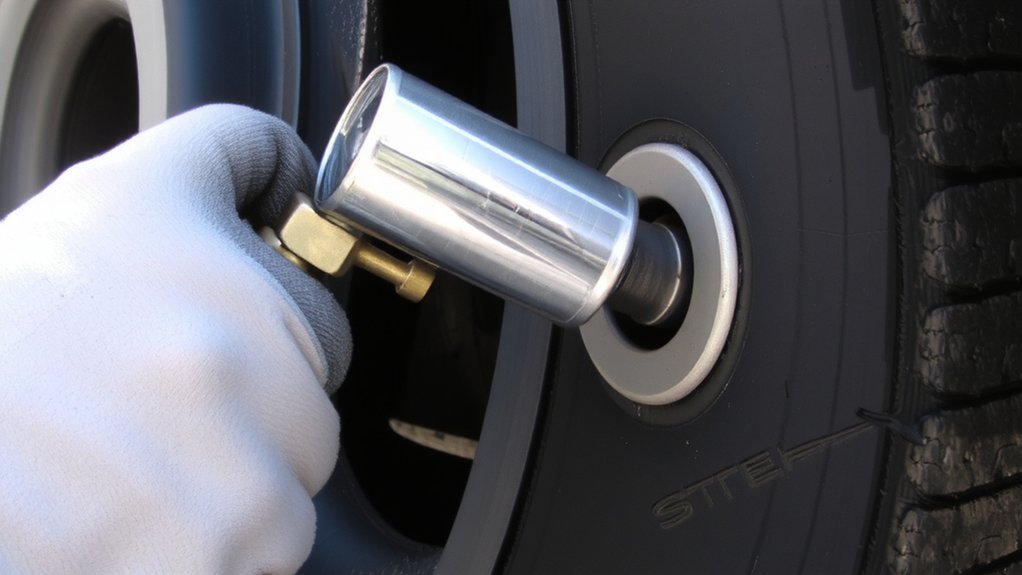You want accurate tire pressure and reliable handling, so you check with a gauge. Take off the valve cap, press the tool squarely, and note the number it gives. Different gauges work a bit differently, and you’ll need to compare that number to your vehicle’s specs. Keep going to learn how to get consistent, accurate results and correct the pressure safely.
Why Tire Pressure Matters

Because tire pressure directly affects your car’s safety and efficiency, keeping it correct matters more than most drivers realize.
You rely on proper inflation for predictable handling, shorter braking distances, and stable cornering; underinflation makes tires flex, heat up, and wear prematurely, while overinflation reduces contact patch and grip.
Fuel economy suffers with low pressure, so you’ll spend more at the pump.
Uneven pressure speeds tread wear and can hide alignment or suspension issues, so you should check pressure monthly and before long trips.
Cold weather drops pressure, so adjust for temperature.
By monitoring and maintaining the right PSI you’ll extend tire life, improve safety, and save money, making routine checks a small habit with big payoff.
Don’t ignore the pressure warning lights either.
Types of Tire Pressure Gauges

When you shop for a tire pressure gauge, you’ll see three main types—pencil (stick), dial, and digital—each trading off cost, durability, and ease of use. Pencil gauges are slim, inexpensive, and portable; a rod pops out to show pressure, but they’re less durable and can be hard to read quickly.
Dial gauges use a round face and needle, offering ruggedness and decent accuracy; they work well for shop use and often have swivel heads and larger ranges. Digital gauges give fast, easy-to-read measurements, backlit displays, and higher precision, though they need batteries and can be pricier.
Choose based on how often you’ll use it, whether you need quick reads, and if ruggedness or precision matters most to you. Also consider warranty and battery life.
When to Check Tire Pressure

Regularly check your tire pressure at least once a month and before any long trip, heavy load, or after a sudden temperature change, since pressure drops as temps fall and rises as they climb.
Also check when your TPMS warning light appears, after hitting a pothole or curb, and any time you feel unusual vibration or pulling.
Check after seasonal shifts; cold mornings often show lower readings than warm afternoons.
Always measure when tires are cold for consistent results, ideally after the car’s been parked three hours or driven less than a mile.
If you store a vehicle for weeks, inspect pressures before driving.
Carry a portable gauge for unexpected needs, and recheck after repairs or slow leaks to confirm stability and safety assurance.
How to Attach a Gauge Properly

Start by removing the valve cap, wiping the stem clean, and aligning the gauge straight onto the valve so you get a solid seal.
Hold the gauge perpendicular and press firmly until you hear a brief hiss stop; that hiss means air’s flowing and the seal’s forming.
Keep your wrist steady and avoid tilting, which causes leaks and false lows.
If using a stick-style gauge, push all the way in; for a chuck, press evenly and hold for one to two seconds.
Replace the cap when finished.
If you feel resistance or continuous hissing, reposition and try again.
Check each tire the same way, doing the spare too.
Clean the stem after use and store the gauge dry.
Inspect the gauge before each use.
How to Read Different Gauge Types

Although gauges differ in form, you’ll read each type the same way: get a solid seal, watch the indicator, and compare the value to your recommended pressure.
For stick-type gauges press firmly; a metal rod will extend showing PSI — read the tip alignment.
For dial gauges push on the valve and note where the needle stops; give it a second to settle.
For digital gauges press the stem, read the numeric display, and watch for a backlight or hold feature that freezes values.
Some compact pen gauges combine a slide and tiny dial; treat them like sticks.
Make sure units match your vehicle’s spec (PSI versus kPa).
Take two quick readings per tire to verify consistency.
Record the number before removing the gauge.
What to Do After Reading Your Tires
If the reading matches your vehicle’s recommended PSI, replace the valve cap, note the value, and move on; if it’s too low or too high, add or bleed air until it matches, then recheck to confirm.
After you finish all four tires (and the spare if you carry one), record the pressures and the date in your maintenance log or phone.
Drive a short distance, let tires settle, then recheck to ensure pressure stayed stable. If pressures drop again, inspect for nails, punctures, or valve leaks and tighten the valve stem.
Visit a shop for repairs or replacement if you find damage. Check pressures monthly and before long trips to maintain handling, fuel efficiency, and tire life. Replace valve caps lost during checks promptly.
Conclusion
Now that you know how to check tire pressure, keep a gauge handy and check your tires when they’re cold at least once a month and before long trips. You’ll press the gauge squarely, read the PSI (or kPa), and compare it to the manufacturer’s recommendations. If needed, add or release air and recheck. Maintaining proper pressure improves safety, fuel economy, and tire life, so make this simple habit part of your routine every time.